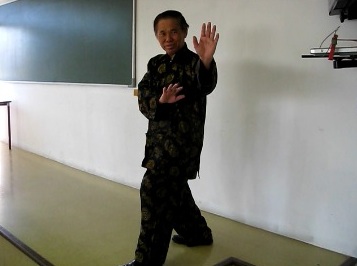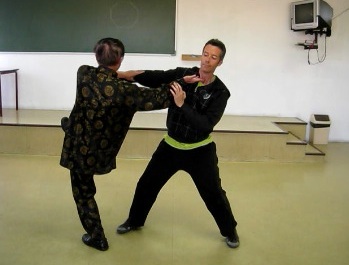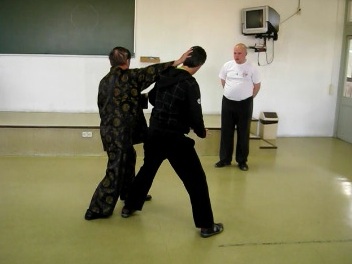INTERESTING ASPECTS OF BAGUAZHANG DISCOVERED WHILE PREPARING TO TEACH IT

Baguazhang Circle Walking can generate a lot of internal force
Question
What is the main thing or key point that Sifu has learned or discovered while reviewing, practicing and teaching Baguazhang?
Sifu Matt Fenton
Answer
I have learnt many interesting things about Baguazhang when I prepared to teach Baguazhang at the UK summer Camp 2012. These invaluable lessons not only enrich my teaching of Baguazhang but also enrich my teaching as well as my own performance and understanding of other kungfu styles
As I did not learn Baguazhang formally from a teacher, my understanding of Baguazhang was vague and haphazard. I knew that unlike Shaolin Kungfu, there were not many Baguzzhang sets. In fact I heard that there was only one set, Swimming Dragon Baguazhang Set. I also knew that the core of Baguazhang was the eight Mother Palms, and that there were 64 characteristic Baguazhang techniques.
Apart from this general information, my understanding of Baguazhang was haphazard. So I decided to make an extensive as well as in-depth study of the art. Fortunately I have a good collection of Baguazhang classics, most of which were bought years ago but I did not really study them. After deciding to teach Baguazhang I visited many book shops to buy more Baguazhang books, but unfortunately nowadays books on any kungfu philosophy and in-depth practice are sorely lacking.
On the other hand, I could get a lot of material from the internet, especially from YouTube. However, one must be careful that much of the material is mediocre. There is also some very good material. From all this information I could have a clear picture of Baguazhang.
One of the most rewarding things I have learnt about Baguazhang is to use the Mother Palms and Circle Walking of Baguazhang for developing internal force. Interestingly, I picked up this idea not from Baguazhang classics or videos but from a classic on Praying Mantis Kungfu! There was a mention that certain Praying Mantis patterns could be held in a fixed position like in stance training for developing internal force. Another classic on Northern Shaolin describes holding certain Northern Shaolin patterns in a fixed position, and when tired move on to another pattern in another fixed position, and so on in a circle.
This led to my thinking of the eight Mother Palms and Circle Walking in Baguazhang. I tired out the training myself and was amazed at the tremendous amount of internal force created. This gave me a likely answer to my question which I had asked myself in the past, i.e. how did Bagauzhang masters had so much internal force. There was not much mention of internal force training in Baguazhang classics. I went into meditation and had signals that past Baguazhang masters did the same training method that I tried out.
Hence, I was very happy when later I read in one of the Baguazhang classics, Internal School of Baguazhang by Ngai Cheng Woh, that strongly suggested that using the Mother Palms and Circle Walking was an important method of force training in Baguazhang. As it is typical in kungfu classics, the master did not explicitly say so. He merely listed two sets of Mother Palms, the external set which is frequently shown in Baguazhang literature, and the internal set which has never been shown.
Readers without background knowledge would probably miss this very important information. They may even argue that the internal set the master showed was not genuine as they have never practiced it or never seen it. When visitors to YouTube say that our combat applications are useless, because they do not know how to use them, you can have a picture of how easily people miss useful information even when it is generously given.
It is worthy of note that many of the hand patterns of the internal Mother Palms are similar to those in our Shaolin Kungfu stance training though the stances are different, like Two Dragons Embrace Sun, Unicorn Carries Moon and Lohan Carries Water. In Shaolin Kungfu we use the Bow-Arrow Stance, the Unicorn Stance and the Horse-Riding Stance respectively, whereas in Baguazhang the typical Baguazhang Stance is used.
We tried out this secret Baguazhang force training method at the Baguazhang course during the UK Summer Camp 2012, and course participants were amazed at its effectiveness.

Baguazhang combat application is very sophisticated
Another very rewarding thing that I learned while preparing for the 2012 Baguazhang course and which participants verified at the course, is using chi flow in Circle Walking. This is related to but not the same as using the Mother Palms to develop internal force. In internal force development, practitioners move from one stance or Mother Palm to another, after staying at a particular stance for some time. The Circle Walking is transitional. In using chi flow in Circle Walking, the walking is the main training; practitioners do not stop at any stances.
The key point here is not just Circle Walking, which is performed by all Baguazhang practitioners, but using chi to do the walking, which I believe only Baguazhang masters could do but without their conscious knowing. At the Baguazhang course 2012, all participants were taught how to use chi to do their Circle Walking, and all did very well.
What is the difference between using chi to do the Circle Walking and using muscles to do the Circle Walking as done by other practitioners? When you use chi to do the walking, you can be very fast and agile, yet you are not tired. When you use muscles to do the walking, you are not as fast and agile, and you become tired more easily.
Using chi to do Circle Walking was never mentioned in Baguazhang classics, but it is a natural progression in our training. To others it is impossible; to us it is natural. Why is it so? Yes, it is because of the magic of chi flow.
A third very rewarding thing I have discovered while preparing to teach Baguazhang was the combat application of some strange looking Baguazhang patterns like Cloud Dragon Rushes to Sky, Cloud Dragon Returns Head, Horizontally Bar Rushing Horse, and Lift Hand Touch Sky.
I have been well known for my ability to see combat applications of patterns where many other people would not have the faintest idea. Yet, I was amazed by both the beauty and sophistication of many Baguazhang combat applications.
Take Cloud Dragon Rushes to Sky, for example. What function could be served by bending the body in an awkward position and lifting one hand high up? I am quite sure that many participants at the Baguazhang course of 2012 were astonished when the combat applications of this and some other apparently flowery Baguazhang patterns were revealed.
Turning about is frequently seen in Baguazhang performance. At first I wondered why a Baguazhang exponent should turn his body in combat, as it would make his movement slower and also it would expose his back to his opponent. I was sure there must be a good reason for the turning, but at first I could not find out the reason.
When preparing to teach Baguazhang, the reason revealed itself. While generally it would be disadvantageous to turn the body, there were situations when such turning would be advantageous. It would actually make the execution of some patterns faster, and enable the exponent to be safer.
So, there are many things or key points I have learned while preparing to teach Baguazhang. But, to answer the question directly, what is the main thing or key point amongst these many things and key points? It is the discovery that a typical Baguazhang pattern has three planes, whereas a Taijiquan pattern has two, and a Shaolin pattern has one.
To illustrate this point, let us take the typical Baguazhang pattern, Green Dragon Tests Claw. When a Baguazhang exponent performs this pattern in the left mode, i.e. with the left hand and left leg in front, if his legs are aligned to the north, his body is aligned to north-west, and his hands are aligned to the west. Hence, there are three planes -- north, north-west and west.
When a Taijiquan exponent, facing north, performs Immortal Waves Sleeves, for example, his legs and body are aligned to the north, and his hands are aligned to north-west. There are two planes – north and north-west.
When a Shaolin exponent, facing north, performs Single Tiger Emerges from Cave, for example, there is only one plane. His legs, body and hands are all aligned to the north.
This interesting point was never mentioned in the classics. Future martial artists will find history in this answer. I believe that Baguazhang employing three planes was evolved from actual experience. Baguazhang masters found using three planes instead of one or two enabled them to be more effective in certain aspect of combat.
What do you think is this aspect? Yes, it enables a Baguazhang exponent to attack the back of an opponent more effectively -- a hallmark Baguazhang is famous for.

The three-plane patterns of Baguazhang enable practitioners to get to an opponent's back effectively
The questions and answers are reproduced from the thread 10 Questions to Grandmaster Wong -- Baguazhang (Pakua Kungfu) in the Shaolin Wahnam Discussion Forum.
LINKS
